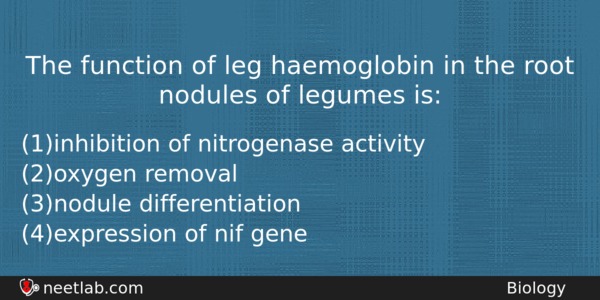| ⇦ | 
| ⇨ |
The function of leg haemoglobin in the root nodules of legumes is:
Options
(a) inhibition of nitrogenase activity
(b) oxygen removal
(c) nodule differentiation
(d) expression of nif gene
Correct Answer:
oxygen removal
Explanation:
Leghaemoglobin is the haemoglonin like red pigments found in root nodules of legumes and reported to function as an oxygen-carrying pigment in symbiotic nitrogen fixation.
Related Questions: - In gel electrophoresis, differential mobility of DNA depends upon
- DNA content is doubled during
- HIV codes for the gene (s)
- During aerobic respiration maximum ATP is synthesized by
- Conversion of milk to curd improves its nutritional value by increasing the
Question Type: Memory
(964)
Difficulty Level: Easy
(1008)
Topics: Plant Physiology
(28)
Subject: Biology
(4253)
Important MCQs Based on Medical Entrance Examinations To Improve Your NEET Score
- In gel electrophoresis, differential mobility of DNA depends upon
- DNA content is doubled during
- HIV codes for the gene (s)
- During aerobic respiration maximum ATP is synthesized by
- Conversion of milk to curd improves its nutritional value by increasing the
Question Type: Memory (964)
Difficulty Level: Easy (1008)
Topics: Plant Physiology (28)
Subject: Biology (4253)
Important MCQs Based on Medical Entrance Examinations To Improve Your NEET Score
18000+ students are using NEETLab to improve their score. What about you?
Solve Previous Year MCQs, Mock Tests, Topicwise Practice Tests, Identify Weak Topics, Formula Flash cards and much more is available in NEETLab Android App to improve your NEET score.
Share this page with your friends

Leave a Reply